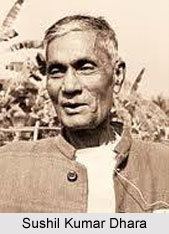Nationality Indian Name Sushil Dhara | Role Political leader | |
 | ||
Born 2 March 1911Tikarampur, Midnapore ( 1911-03-02 ) Occupation Freedom Fighter, Elected Official Died January 28, 2011, Mahishadal (community development block), Purba Medinipur district | ||
Sushil Kumar Dhara (Bengali: সুশীল কুমার ধাড়া) (2 March 1911 – 28 January 2011) was a revolutionary in British India and a political leader after Indian independence in 1947.
Dhara was born on 2 March 1911 in Tikarampur (near Tamluk) in Mahisadal in the present Purba Medinipur district into a Hindu family. He was involved in political activities from his school days. He completed his education from Vidyasagar College in the year 1937. Later, in 1940, he participated in the Satyagraha movement of Gandhiji. In August 1942 he played the lead role in launching an anti-British movement in undivided Midnapore. The movement helped to free Tamralipta from British rule and a free government was formed in this region on 17 December, 1942. Vidyut Bahini, of the parallel Government of Tamluk was also commanded by him. During the reign of British, Sushil Kumar Dhara spent 12 years and 4 months in prison.
Post independence, Sushil Kumar Dhara entered the political area of India. He won several elections which also included the Mahishadal seat of West Bengal Assembly in 1962, 1967 and 1969. In 1962, he was the winner of the Assembly poll as a Congress candidate. He also created the Bangla Congress in the year 1966. In the year 1967 Prafulla Sen was defeated at Arambagh by another Gandhian Ajoy Mukherjee, who became chief minister of West Bengal after Prafulla Chandra Sen. Architect of Ajoy Mikherjee's victory at Arambagh was Narayan Ch Ghosh the then students leader there. Sushil Kumar Dhara had inspired students of Arambagh unfolding his image as commander of Vidyut Bahini, of the parallel Government of Tamluk in British India. In 1967, he had won the poll as a candidate of Bangla Congress. He also served the state government as `Industry and Commerce Minister`. He had published a book named 'Ken ei banya' written by Narayan Ch Ghosh for circulating in lower Damudar basin. Reading noted book people there were very much agitated and took effective role against Congress. Later Ajoy Mukherjee with some of his closed colleagues, viz. Pranob Mukherjee etc., joined Indian National Congress leaving Sushil Dhara - his long term associates. Ajoy Mukherjee had pushed Pranab Mukherjee to be State Minister in the Indian Cabinet.In 1977, from the Tamluk constituency, Sushil Dhara was elected to the Lok Sabha as a candidate of the Janata Party.
For Sushil Kumar Dhara is no common mortal, he was an imperative functionary of Tamralipta Jatiya Sarkar which is better known as Tamralipta National Government. This national government was formed during the 1942 August Movement. He was entrusted the portfolios of War and Home, and also commanded "Vidyut Bahini" (the lightning Brigade) of the parallel Government in Tamluk in colonial times. Sushil Kumar Dhara was again a minister of West Bengal in the late 60`s. An affirmed supporter and disciple of Mahatma Gandhi and a bachelor fully devoted to social service, Sushil Kumar Dhara was full of life and energy. He delights in making quick nostalgia of the past; though equally live to the trends of the modern times - the growth of Indian independent democracy, the challenges before the nation and above all, her march towards the twenty first century in a global economy too.
Sushil Kumar Dhara had a firm belief that the responsibilities of the nation must be undertaken by the young generation for the smooth functioning of democracy. He stepped back from politics in 1980s and involved himself actively in social work. This great revolutionary died on 28 January 2011, at the age of 100, owing to prolonged sickness.
